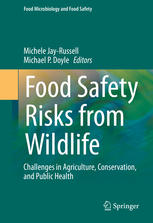

Most ebook files are in PDF format, so you can easily read them using various software such as Foxit Reader or directly on the Google Chrome browser.
Some ebook files are released by publishers in other formats such as .awz, .mobi, .epub, .fb2, etc. You may need to install specific software to read these formats on mobile/PC, such as Calibre.
Please read the tutorial at this link: https://ebookbell.com/faq
We offer FREE conversion to the popular formats you request; however, this may take some time. Therefore, right after payment, please email us, and we will try to provide the service as quickly as possible.
For some exceptional file formats or broken links (if any), please refrain from opening any disputes. Instead, email us first, and we will try to assist within a maximum of 6 hours.
EbookBell Team

4.8
74 reviewsFoodborne illnesses caused by zoonotic pathogens associated with wildlife hosts are an emerging microbial food safety concern. Transmission of foodborne pathogens can occur through ingestion, or improper handling, of contaminated game meat. Wild and feral animals have also been investigated as potential sources of Campylobacter, Escherichia coli O157:H7 and other enteric pathogens following foodborne disease outbreaks linked to fresh fruits and vegetables (e.g., baby spinach in California, shelled-peas in Alaska, strawberries in Oregon). This book explores the range of bacterial, parasitic, and viral pathogens that have been described in wildlife populations in the United States, Europe and other parts of the world. It also addresses important challenges and solutions to balance agriculture, conservation, and public health goals. The book provides unique information on approaches in risk communication, co-management, and One Health in a wildlife-food safety context. The first five chapters review research on the detection, epidemiology and ecology of foodborne pathogens in wildlife populations including the influence of wildlife-livestock-human interactions. The second half of the book addresses current guidelines to mitigate microbial food safety risks from wildlife hosts and new regulations proposed by the U.S. Food and Drug Administration in the Food Safety Modernization Act Produce Safety Rule. Chapters are written by an array of internationally reco
gnized authors, and will be of interest to agriculture safety experts, ecologists, environmental health specialists, food safety professionals, microbiologists, public health practitioners, veterinarians, wildlife biologists, and others in academia, government, industry, and students in these disciplines.